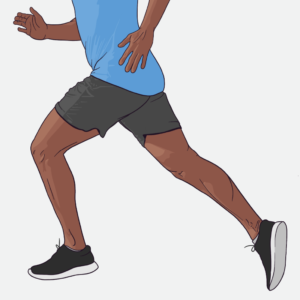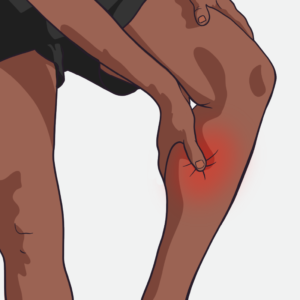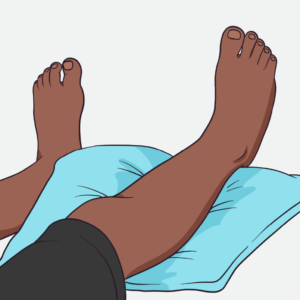How to Recover from a Pulled Calf Injury
It’s happened to all of us at least once or twice – we misstep during a run or land in an odd position from a jump and end up straining or pulling a calf muscle in the process. While typically not the most serious of injuries to face, a pulled muscle can still be a significant setback to your workout routine, so it’s important to address it properly so you can be on the road to recovery quickly and efficiently.
Read on to learn more about the most common causes and symptoms of a pulled calf, along with the suggested treatment and timeline to recovery.
Causes


The most common causes of calf muscle pulls or strains tend to be sports or exercise-related. As mentioned above, something as simple as a misstep during a basketball game or even regularly wearing high heels can result in a pulled calf. Other commonalities among calf injuries include not properly warming up before participating in physical activity and ill fitted or poorly designed shoes or footwear.
Symptoms


A pulled calf muscle impacts the muscles and tendons in the back of the lower leg. Calf strains can vary significantly in terms of severity, which will have an impact on the type and severity of symptoms you experience. A mild calf pull may feel similar to the soreness you experience after an especially intense workout, whereas a more serious calf injury may make it feel incredibly painful or even impossible to walk.
Here are some of the most common symptoms of a calf strain or pull:
- Swelling
- Redness
- Bruising
- Muscle cramps or spasms
- Feelings of sharp pain in the lower leg
- Inability to walk comfortably
Treatments


A consultation with a doctor can help you determine the best treatment plan for your calf pull injury, and their recommendations will depend on the degree of severity of the injury.
Some of the most common treatment recommendations doctors will make for calf pulls are:
- Resting the calf muscle: Taking a break from your regular physical activity is necessary to focus on treating the injury and allowing time for the calf muscle to heal. Refrain from returning to normal activity until the muscle is completely healed to avoid further injury.
- Icing the calf muscle: An ice pack or cold compress placed on the calf muscle can help relieve pain and inflammation. In the first few days following the initial injury, you should aim to ice the calf for 20 minutes up to eight times per day.
- Heating the calf muscle: Switching to heat compresses on a low setting following a few days of icing the injury regularly can help with muscle soreness and stiffness.
- Elevating the calf muscle: Keep the injured calf propped up on a table or surface to help decrease swelling. Aim to prop your leg above heart level.
- Wrapping the calf muscle: Keeping the calf muscle wrapped in an elastic bandage or some type of compression sock can help reduce swelling and increase mobility
- Taking over-the-counter pain relievers: Unless your doctor has instructed against this, you can take acetaminophen or ibuprofen for pain relief. Ibuprofen can also help reduce swelling.
Additionally, there are various types of stretches that can help with the recovery of the pulled calf muscle. We’ve included one example of each type below. Note, you should check with your doctor before trying any of these at home.
- Wall stretches: Stand in front of a wall, placing both hands firmly against the wall. Keep your injured leg straight with your heel pressed firmly into the ground. Step your other leg forward into a lunge position, aiming for a 90-degree angle. You’ll feel a stretch in your straight leg as you deepen the bend in your bent leg. Hold for 15-30 seconds before releasing and repeat.
- Floor stretches: Sit on the floor, extending both legs out straight. Reach forward for your toes and carefully flex your feet towards you, keeping your heels on the floor. Pull your toes toward you for a deeper stretch, holding the stretch for 3-5 seconds. For those with less flexibility, the same stretch can be done using a towel or resistance band.
- Standing stretches: Stand up straight and raise your heels, lifting the body up on the balls of your feet. Aim to hold the heels above the ground for 3-5 seconds, then carefully lower. You can always hold onto the back of a chair or other stable surface for assistance with stability and balance.
If symptoms and pain continue after treating the calf injury with the above common methods, you should consult with your doctor as you may be dealing with a more serious injury. More serious calf injuries may require physical therapy or even surgery.
Timeline to Recovery
Similar to the symptoms you’ll experience and the treatment plan you should follow, the timeline to full recovery of a pulled calf injury depends on the severity of the injury. For milder calf pull injuries, you may be back to your regular workout routine after a few days of rest and following the provided treatment alternatives. For more severe cases, it could take much longer than that.
It’s important to wait until the calf muscle heals completely before going back to your regular level of routine physical activity. Jumping back into things before the muscle is ready can extend the timeline of the injury, or lead to a second injury.
To close, there a few ways to avoid additional calf injuries, and for anyone that’s experienced one can attest to, that are worth incorporating into your regular routine including:
- Warming up before exercising, including leg stretches
- Cooling down properly after working out, including leg stretches
As always, if your calf injury or any other injury persists, it’s best to consult a doctor to determine the best path forward towards recovery.
